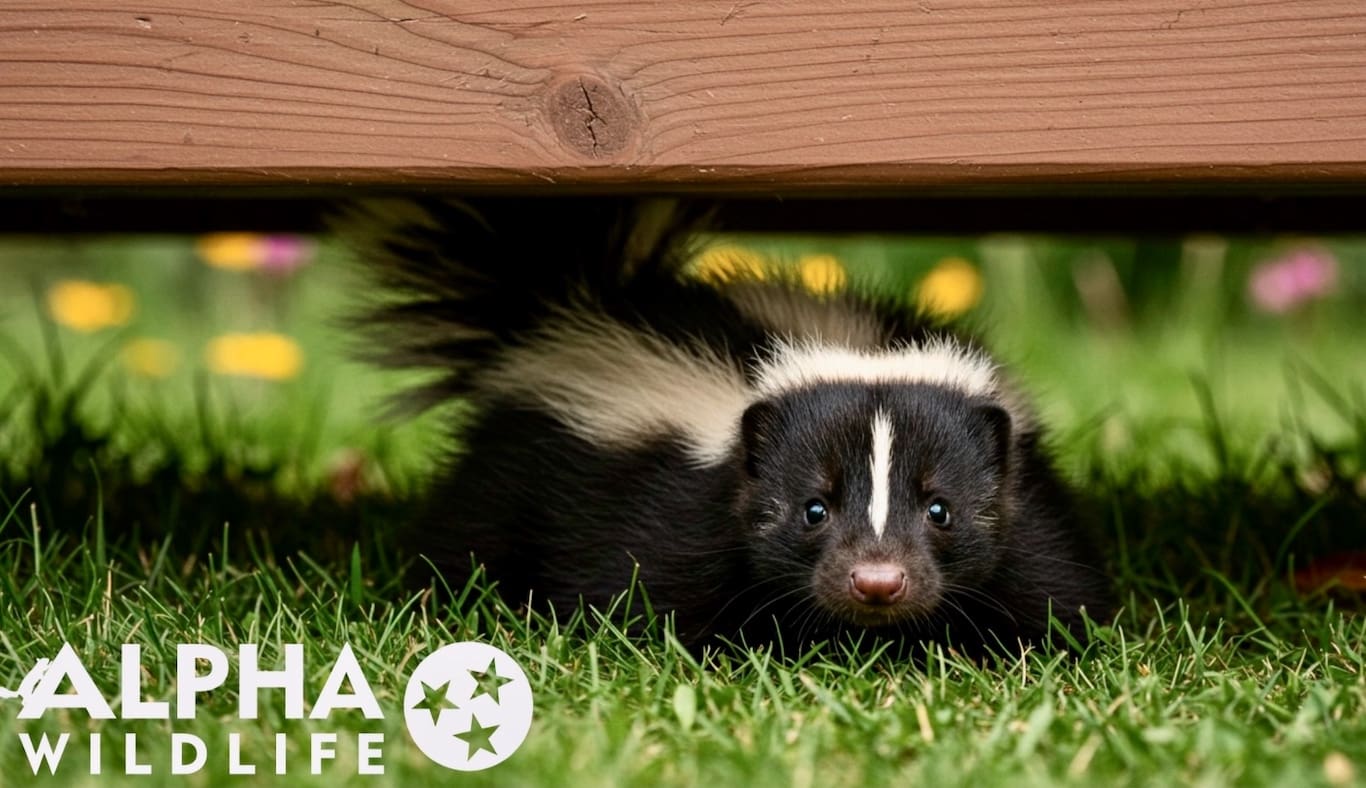Quick Answer
Wondering if you’ve got skunks under the house? Well, if your home constantly reeks of the powerful “skunk funk,” your beautiful yard now has small holes in it, and you’re hearing scratching noises at night—a family of skunks might be living rent-free nearby.
Below, we’ll break down the top 5 signs of a skunk infestation, what attracts them in the first place, and how to stop these stinky pests for good.
Getting To Know The Enemy: Understanding Skunk Behavior
To you, that dark spot under your porch or deck is just a playground for bugs and other insects. It probably grosses you out just thinking about what’s under there.
Skunks have a different view though. These furry critters see that dark spot under the shed or in your crawlspace as a quiet, protective space for their babies. They also see it as an easy access point for food (bugs, grubs, anything from your trash can buffet). If your home checks those boxes, skunks will think of it as a 5-star resort.

The Top 5 Signs of a Skunk Infestation
- The Infamous Skunk Smell
We’ve all experienced that moment when you’re driving, and the smell hits you like a ton of bricks. You can’t roll the window down and you can’t drive through it fast enough. The skunk spray is the ultimate defense mechanism that can stay with you for days. If the funky odor constantly drifts into your home, there’s a good chance a skunk is nearby.
- Small Holes in the Lawn
Like an old man at the beach with a metal detector, skunks are scanning your yard for grubs, and they’ll make little holes to find them. Now, the holes aren’t massive. Typically, they’re only 2-3 inches wide. If you notice that your lawn has developed chicken pox overnight, you probably have some skunks under your deck to thank for it.
- Skunk Tracks
You’ve all seen those cop shows where the detectives find shoe prints outside of the victim’s home. Well, you are now deputized in your defense against skunks. Look in muddy areas near decks or porches to find their paw prints—five toes and long front claws. If you do find skunk prints, feel free to rip off your sunglasses and say something clever like “this case is about to get stinky.”
- Damage to Wiring, Insulation, or Ductwork
Skunks don’t care if you have a new HVAC unit or how much you’ve spent on house upgrades. These sneaky critters can cause expensive damage getting in or moving around under your home. Chewed wires (hello, fire hazard), shredded insulation, and torn ducts can all be part of their “home improvement” projects. Unfortunately, you can’t call the skunk contractor and tell them to put everything back the way it was before.
- Nighttime Scratching or Rustling
Skunks take the term midnight snack to a whole new level. These nocturnal creatures will be out and about while you sleep, so that you have a nice surprise the next morning. If you hear scratching, thumping, and rustling under the floorboards, a mother skunk might be entertaining her kits or other guests.
What Attracts Skunks to a Home?
- Easy meals: insects, grubs, fruits, veggies, pet food, garbage
- Shelter: dark, enclosed areas safe from predators
- Neglected yards: overgrown shrubs, woodpiles, debris piles
If your home offers all three, you’re basically running a free skunk bungalow.

When Skunks Under the House Become a Problem
While skunks help control insect populations, they can:
- Spread rabies, leptospirosis, and parasites
- Cause costly property damage to wiring, insulation, and ductwork
- Spray pets or people, causing temporary blindness and nausea
- Dig up lawns and gardens
Don’t let these critters ruin your beautiful home. We offer services in Memphis, Nashville, Knoxville, Chattanooga, & Columbia.
FAQs About Skunks Under the House
Q: How can I tell for sure if there’s a skunk under my house?
Look for strong odors, small cone-shaped holes, tracks, nighttime noises, and any signs of damage to insulation or wiring.
Q: Is it safe to handle a skunk problem myself?
It’s risky — skunks can bite, scratch, or spray. DIY removal can also accidentally trap babies inside. Professional help is safest.
Q: How can I prevent skunks from moving in?
Seal all crawl space and deck openings, secure trash, bring in pet food, and keep your yard clear of clutter.
Q: Can a skunk get in your attic?
Yes, but it’s not very common. It’s more likely for a skunk to dig under sheds or decks and hide in crawlspaces.

Dealing with Skunks the Humane Way
If you suspect a skunk, confirm with visual signs or a motion-activated camera. Humane solutions include:
- Exclusion: Encourage them to leave using light/noise deterrents, then seal the entry point.
- Repellents: Use safe, natural deterrents like predator scent granules or commercial sprays.
- Removal: Best left to the pros to avoid spraying accidents.
Final Takeaway
Skunks are always the cute and funny animals in animated movies. However, in the real world, these guys would make terrible roommates, and their “scent” would scare away all of your friends and neighbors. By spotting the signs early and removing what attracts them, you can avoid costly damage and the unpleasant aroma of the potent skunk smell.
If you’ve got uninvited, stripe-tailed tenants, Alpha Wildlife’s NWCOA-certified team uses humane methods to remove skunks and keep them from coming back — so your home stays safe, stink-free, and skunk-free. We are BBB Accredited and have hundreds of reviews from verified customers that prove we are the best in the business. Call us today for a free inspection!



